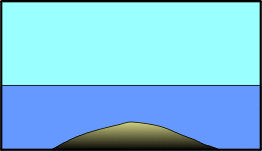|
The Northwestern Hawaiian Islands are part of a long line of volcanoes that extend from Big Island of Hawaii to the coast of Asia. At one place under the Pacific Plate that forms the bottom of the Pacific Ocean, a hot plume of molten rock pushes out lava and creates underwater volcanic mountains. As the Pacific Plate slowly grinds northwest over the hotspot, a chain of volcanoes is produced. That hotspot has created the Main Hawaiian Islands, the Northwestern Hawaiian Islands and the Emperor Seamount Chain. It has been erupting from underneath the Pacific Plate for more than 50 million years. The undersea volcanoes grow and eventually are exposed on the surface, continuing to grow as long as new lava is extruded.

After millions of years, when an island has moved off of the hotspot, its lava source is cut off and the volcano above gradually dies. Now erosion and subsidence begin to take their toll. This process, while inevitable, takes millions of years, during which time, plants, animals, and coral reef communities colonize and evolve on the islands. Eventually though, all that is left of even the largest islands is a ring of coral, an atoll. Given enough time, this too will sink under the waves, eventually sinking so low that corals cannot grow and maintain the atoll. These underwater mountains are called guyots.
|

